When it comes to Chinese-American cuisine, few dishes spark as much curiosity and debate as chow mein and lo mein. These two noodle-based staples have graced the menus of countless restaurants, from bustling urban takeout joints to cozy suburban diners. At first glance, their names sound similar, and both feature noodles, vegetables, and proteins tossed in savory sauces. Yet, ask any food enthusiast, and they’ll tell you that chow mein and lo mein are distinctly different, each with its own preparation methods, textures, and cultural significance. In this exploration, we’ll unravel the differences and similarities between chow mein and lo mein, diving into their histories, ingredients, preparation techniques, regional variations, and cultural impact, while also addressing common misconceptions and offering insights into how these dishes have evolved in the American culinary landscape.
Origins and Cultural Context
To understand chow mein and lo mein, we must first look to their roots in Chinese cuisine. Both dishes hail from China, but their modern iterations, especially in the United States, reflect adaptations shaped by immigration, ingredient availability, and evolving tastes.
Chow Mein: The Crispy Classic
The term “chow mein” comes from the Mandarin Chinese “chǎo miàn” (炒面), which translates to “stir-fried noodles.” The word “chǎo” means to stir-fry, and “miàn” refers to noodles, pointing directly to the dish’s defining characteristic: noodles that are stir-fried to achieve a particular texture, often crispy. Chow mein has its origins in Northern China, where wheat-based noodles were a dietary staple. Stir-frying noodles with vegetables, meats, and seasonings was a practical way to create flavorful, hearty meals.
When Chinese immigrants arrived in the United States during the 19th century, particularly during the California Gold Rush, they brought their culinary traditions with them. However, limited access to authentic ingredients and the need to cater to Western palates led to the creation of the Chinese-American version of chow mein. By the early 20th century, chow mein had become a hallmark of Chinese-American restaurants, especially in cities like San Francisco and New York. One notable adaptation was the introduction of crispy chow mein, where noodles are fried until golden and crunchy, then topped with a saucy stir-fry of vegetables and protein. This style became iconic, particularly on the East Coast.
Lo Mein: The Soft and Saucy Counterpart
Lo mein, derived from the Cantonese “lou mihn” (撈麵), translates to “tossed noodles” or “stirred noodles.” Unlike chow mein, the term doesn’t emphasize stir-frying the noodles themselves. Instead, lo mein involves boiling noodles and then tossing them with a sauce, vegetables, and protein. The dish is associated with Southern China, particularly Cantonese cuisine, where softer, chewier noodles were popular.
In the U.S., lo mein emerged as a softer, saucier alternative to chow mein, likely because it was easier to prepare in large quantities and appealed to American diners who preferred a less crunchy texture. Over time, lo mein became a mainstay on Chinese-American menus, often featuring a glossy sauce that coats the noodles, making every bite rich and flavorful.
Key Differences in Preparation
The most significant distinction between chow mein and lo mein lies in their preparation methods, which directly influence their texture and presentation.
Chow Mein Preparation
Chow mein is defined by its stir-fried noodles, which can be prepared in two primary styles: crispy and soft.
- Crispy Chow Mein: In this style, popular in many American restaurants, the noodles are fried until they form a crispy, golden nest or pancake. The stir-fried toppings—typically a combination of vegetables like cabbage, carrots, onions, and bean sprouts, along with proteins like chicken, beef, pork, shrimp, or tofu—are cooked separately in a wok with a light sauce, often made with soy sauce, oyster sauce, or hoisin. The saucy mixture is then poured over the crispy noodles, creating a contrast between the crunchy base and the tender, flavorful topping. This style is particularly associated with East Coast Chinese-American cuisine.
- Soft Chow Mein: More common in West Coast restaurants and closer to the traditional Chinese preparation, soft chow mein involves stir-frying the noodles along with the vegetables and protein in a wok. The noodles, typically egg noodles, are parboiled briefly to soften them before being tossed into the hot wok with oil, sauce, and other ingredients. The result is a dish where the noodles are slightly chewy with a hint of crispiness from the stir-frying process, and all components are evenly coated in sauce.
Lo Mein Preparation
Lo mein, by contrast, focuses on boiled noodles that are tossed with a sauce rather than stir-fried. The preparation process is simpler:
- Boiling the Noodles: Lo mein noodles, usually egg noodles or wheat noodles, are cooked in boiling water until al dente. They are then drained and set aside.
- Stir-Frying the Toppings: The vegetables and protein are stir-fried in a wok with oil and seasonings, much like in chow mein. Common vegetables include broccoli, bell peppers, mushrooms, and snow peas, while proteins mirror those in chow mein.
- Tossing Together: The cooked noodles are added to the wok and tossed with the stir-fried ingredients and a sauce, which might include soy sauce, sesame oil, and sometimes a touch of sugar or cornstarch for thickness. The goal is to coat the noodles evenly without frying them, resulting in a soft, slippery texture.
The key takeaway is that chow mein’s noodles are cooked in the wok, giving them a distinct texture (crispy or slightly chewy), while lo mein’s noodles are boiled separately and then combined with the other ingredients, resulting in a softer, saucier dish.
Ingredients: Similarities and Variations
At their core, both chow mein and lo mein share many ingredients, reflecting their shared heritage in Chinese cuisine. However, subtle differences in their preparation can influence the choice of ingredients and their proportions.
Noodles
Both dishes typically use wheat-based egg noodles, which are slightly yellow and have a chewy texture when cooked. In traditional Chinese cuisine, the noodles for chow mein and lo mein might differ slightly in thickness or composition, but in Chinese-American restaurants, the same type of noodle is often used for both. Occasionally, lo mein may feature thicker noodles to absorb the sauce better, while chow mein might use thinner noodles for crispier results in the crispy style.
Proteins and Vegetables
The proteins and vegetables in both dishes are largely interchangeable. Common proteins include:
- Chicken
- Beef
- Pork
- Shrimp
- Tofu (for vegetarian or vegan options)
Vegetables often include:
- Cabbage
- Carrots
- Onions
- Bell peppers
- Bean sprouts
- Broccoli
- Snow peas
- Mushrooms
The choice of vegetables and proteins often depends on regional preferences, restaurant style, or customer requests. For example, coastal areas might emphasize seafood in their chow mein or lo mein, while inland restaurants might lean toward chicken or beef.
Sauces
The sauces for both dishes typically rely on a base of soy sauce, often combined with oyster sauce, hoisin sauce, or sesame oil. Chow mein sauces may be lighter to avoid sogging up crispy noodles, while lo mein sauces are often thicker and starchier to cling to the softer noodles. Additional seasonings like garlic, ginger, and green onions are common in both, adding depth and aroma.
Regional Variations in the U.S.
The preparation and presentation of chow mein and lo mein vary significantly across the United States, reflecting the diverse influences of Chinese immigrant communities and local tastes.
East Coast vs. West Coast Chow Mein
On the East Coast, particularly in New York, crispy chow mein reigns supreme. The fried noodle nest topped with a saucy stir-fry became a hallmark of Chinese-American cuisine in the mid-20th century. This style likely developed because it was visually striking and appealed to American diners who enjoyed the contrast of textures.
On the West Coast, especially in California, soft chow mein is more common, reflecting a closer adherence to traditional Chinese stir-frying techniques. San Francisco’s Chinatown, one of the oldest in the U.S., popularized this style, where noodles are stir-fried with the other ingredients for a cohesive, wok-tossed dish.
Lo Mein’s Consistency
Lo mein, by contrast, tends to be more consistent across regions. Its soft, saucy nature makes it a versatile dish that doesn’t vary as dramatically between coasts. However, some restaurants may adjust the sauce’s sweetness or thickness to suit local palates. For example, Midwestern Chinese restaurants might use a sweeter sauce to cater to American tastes, while urban areas with diverse populations might stick to more traditional Cantonese flavors.
Nutritional Comparison
When comparing the nutritional profiles of chow mein and lo mein, several factors come into play, including preparation method, portion size, and ingredient choices.
- Chow Mein: Crispy chow mein tends to be higher in fat and calories due to the frying of the noodles, which absorb oil. A typical serving of crispy chicken chow mein (about 1 cup) can contain 500–700 calories, with 20–30 grams of fat, depending on the amount of oil used. Soft chow mein is generally lighter, with around 400–600 calories per serving, as the noodles are stir-fried briefly rather than deep-fried.
- Lo Mein: Lo mein is often lower in fat than crispy chow mein because the noodles are boiled rather than fried. A serving of chicken lo mein might range from 400–550 calories, with 15–25 grams of fat. However, the sauce can add sodium and sugar, so lo mein isn’t necessarily a “healthier” option unless prepared with minimal oil and light seasoning.
Both dishes can be made healthier by increasing the vegetable content, choosing lean proteins like chicken or tofu, and reducing the amount of sauce or oil used.
Cultural Impact and Popularity
Chow mein and lo mein have left an indelible mark on American food culture, becoming synonymous with Chinese-American cuisine. Their popularity stems from their affordability, versatility, and ability to appeal to a wide range of tastes.
Chow Mein’s Rise to Fame
Chow mein’s prominence in the U.S. was boosted by its accessibility. In the early 20th century, canned chow mein, complete with crispy noodles and a sauce mix, was sold by brands like La Choy, making it a household staple for Americans experimenting with “exotic” flavors. The dish’s adaptability also helped it thrive—restaurants could tailor chow mein to local tastes, offering everything from shrimp chow mein in coastal cities to vegetable chow mein for vegetarian diners.
Lo Mein’s Quiet Dominance
Lo mein, while less flashy than crispy chow mein, gained popularity for its comforting texture and bold flavors. Its simplicity made it a go-to for takeout orders, and its saucy consistency ensured it traveled well, unlike crispy chow mein, which can lose its crunch. Lo mein’s prominence grew alongside the rise of Chinese-American fast-casual restaurants in the late 20th century, with chains like Panda Express offering their own versions.
Media and Pop Culture
Both dishes have appeared in films, TV shows, and literature as symbols of Chinese-American identity. From scenes of families sharing takeout containers to comedic moments involving chopsticks and noodle slurping, chow mein and lo mein have become cultural touchstones, representing the fusion of Chinese heritage and American innovation.
Common Misconceptions
Despite their popularity, several misconceptions surround chow mein and lo mein:
- They’re the Same Dish: The most common misunderstanding is that chow mein and lo mein are interchangeable. While they share ingredients, their preparation methods and textures set them apart.
- Chow Mein Is Always Crispy: Many assume all chow mein is crispy, but soft chow mein is equally authentic and widely enjoyed.
- Lo Mein Is Healthier: While lo mein avoids fried noodles, its sauce can be high in sodium and sugar, making it comparable to chow mein in terms of nutrition.
- They’re “Inauthentic”: Some purists argue that Chinese-American chow mein and lo mein aren’t “real” Chinese food. However, these dishes reflect the ingenuity of Chinese immigrants adapting to new environments, making them authentic in their own right.
Which Should You Choose?
Choosing between chow mein and lo mein depends on your preferences and mood:
- Choose Chow Mein If: You crave texture, particularly the crunch of crispy noodles or the slight chew of stir-fried ones. It’s ideal for those who enjoy a contrast between the noodles and the saucy topping or a more wok-charred flavor.
- Choose Lo Mein If: You prefer a softer, saucier dish where every bite is coated in flavor. Lo mein is perfect for takeout lovers who want a dish that holds up well during transport.
Both dishes are endlessly customizable. Vegetarians can opt for tofu or extra vegetables, while spice enthusiasts can request chili oil or Szechuan peppers. The beauty of chow mein and lo mein lies in their versatility, allowing diners to tailor them to their tastes.
Recipes to Try at Home
For those eager to recreate these dishes, here are simplified recipes for both chow mein and lo mein.
Crispy Chow Mein Recipe
Ingredients (Serves 2):
- 8 oz egg noodles
- 1 cup sliced chicken breast
- 1 cup shredded cabbage
- 1/2 cup sliced carrots
- 1/2 cup bean sprouts
- 2 tbsp soy sauce
- 1 tbsp oyster sauce
- 1 tsp sesame oil
- Vegetable oil for frying
- 2 cloves garlic, minced
- 1 tsp ginger, grated
- 2 green onions, chopped
Instructions:
- Boil noodles until al dente, drain, and pat dry.
- Heat 1/4 inch of vegetable oil in a skillet and fry noodles in small batches until crispy. Set aside on paper towels.
- In a wok, heat 1 tbsp vegetable oil and stir-fry garlic, ginger, and chicken until cooked through.
- Add cabbage, carrots, and bean sprouts, stir-frying until tender.
- Mix in soy sauce, oyster sauce, and sesame oil. Cook for 1–2 minutes.
- Place crispy noodles on a plate and top with the stir-fry mixture. Garnish with green onions.
Lo Mein Recipe
Ingredients (Serves 2):
- 8 oz egg noodles
- 1 cup sliced beef
- 1 cup broccoli florets
- 1/2 cup sliced bell peppers
- 1/2 cup sliced mushrooms
- 2 tbsp soy sauce
- 1 tbsp hoisin sauce
- 1 tsp sesame oil
- 1 tbsp cornstarch mixed with 2 tbsp water
- 2 cloves garlic, minced
- 1 tsp ginger, grated
- 2 green onions, chopped
Instructions:
- Boil noodles until al dente, drain, and set aside.
- In a wok, heat 1 tbsp vegetable oil and stir-fry garlic, ginger, and beef until browned.
- Add broccoli, bell peppers, and mushrooms, stir-frying until tender.
- Add soy sauce, hoisin sauce, sesame oil, and cornstarch slurry. Stir until sauce thickens.
- Add noodles and toss to coat evenly. Garnish with green onions.
Conclusion
Chow mein and lo mein, while often confused, offer distinct experiences that showcase the diversity of Chinese-American cuisine. Chow mein’s stir-fried noodles, whether crispy or soft, deliver a textural delight that contrasts with lo mein’s saucy, comforting softness. Both dishes reflect the adaptability of Chinese immigrants who transformed traditional recipes to suit new environments, creating culinary icons that remain beloved today. Whether you’re crunching through a plate of crispy chow mein or slurping up saucy lo mein, these dishes invite you to appreciate the interplay of flavor, texture, and history. So, the next time you’re at a Chinese restaurant or cooking at home, consider your mood—crisp or saucy—and let chow mein or lo mein satisfy your cravings.

















